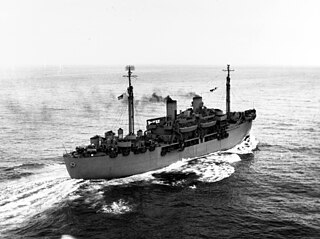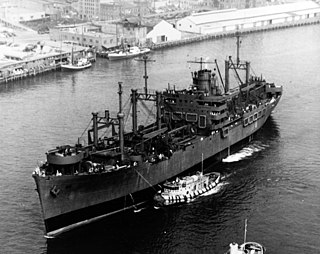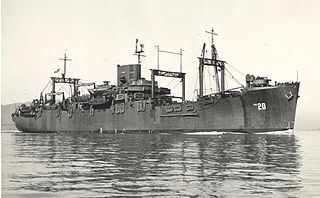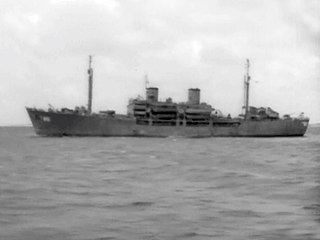
USS Gilliam (APA-57), named for Gilliam County in Oregon, was the lead ship in her class of attack transports serving in the United States Navy during World War II.

USS Geneva (APA-86) was a Gilliam-class attack transport that served with the United States Navy from 1945 to 1947. She was scrapped in 1966.

USS Ottawa (AKA-101) was a Tolland-class attack cargo ship in service with the United States Navy from 1945 to 1947. She was sold into commercial service and was lost in 1951.

USS Sumter (APA-52) was a Sumter-class attack transport that served with the United States Navy from 1943 to 1946. She was subsequently sold into commercial service and was scrapped in 1978.

USS Saint Croix (APA-231), was a Haskell-class attack transport of the United States Navy, able to carry 1,500 troops and their combat equipment, and to land them on a hostile shore using the ship's own landing craft.

USS Barrow (APA-61) was a Gilliam class attack transport serving in the United States Navy from 1944 to 1946. She was scuttled in 1948.

USS Pitkin County (LST-1082) was an LST-542-class tank landing ship built for the United States Navy during World War II. Named after Pitkin County, Colorado, she was the only U.S. Naval Vessel to bear the name.

USS President Hayes (APA-20) was a President Jackson-class attack transport that saw service with the US Navy in World War II. It was named for Rutherford B. Hayes, 19th U.S. president.

USS James O'Hara (APA-90) was a Frederick Funston-class attack transport that served with the US Navy during World War II and later in the Korean War. The ship was named after a Continental Army officer who fought in the Revolutionary War and who later became Quartermaster General of the US Army.

USS Lamar (APA-47) was a Bayfield-class attack transport in service with the United States Navy from 1943 to 1946. She was sold into commercial service in 1948 and was scrapped in 1971.

USS Rockingham (APA/LPA-229) was a Haskell-class attack transport in service with the United States Navy from 1944 to 1947. She was scrapped in 1979.

USS Buckingham (APA-141) was a Haskell-class attack transport in service with the United States Navy from 1945 to 1946. She was scrapped in 1974.

USS McCracken (APA-198) was a Haskell-class attack transport acquired by the U.S. Navy during World War II for the task of transporting troops to and from combat areas.

USS Leon (APA-48) was a Bayfield-class attack transport in service with the United States Navy from 1944 to 1946. She was sold into commercial service in 1947 and was scrapped in 1971.

USS Knox (APA-46) was a Bayfield-class attack transport in service with the United States Navy from 1944 to 1946. in 1947, she was sold into commercial service and was finally scrapped in 1971.

USS Bladen (APA-63) was a Gilliam-class attack transport that served with the US Navy during World War II.

USS Gasconade (APA-85) was a Gilliam-class attack transport that served with the United States Navy from 1944 to 1946. She was sunk as a target in 1948.

USS Rockwall (APA-230) was a Haskell-class attack transport that served in the United States Navy from 1945 to 1947 and from 1951 to 1955. She was scrapped in 1984.

USS Sheridan (APA-51) was an Ormsby-class attack transport that served with the US Navy during World War II.

USS George Clymer (APA-27) was an Arthur Middleton-class attack transport that saw service with the US Navy in four wars - World War II, the Chinese Civil War, the Korean War and the Vietnam War. It was named after United States Founding Father George Clymer.




















